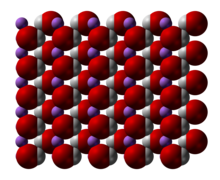
| |
 | |

| |
| Names | |
|---|---|
| IUPAC name
Lithium hydroxide
| |
| Identifiers | |
3D model (JSmol)
|
|
| ChEBI | |
| ChemSpider | |
| ECHA InfoCard | 100.013.804 |
| 68415 | |
PubChem CID
|
|
| RTECS number |
|
| UNII |
|
| UN number | 2680 |
CompTox Dashboard (EPA)
|
|
| |
| |
| Properties | |
| LiOH | |
| Molar mass |
|
| Appearance | white solid |
| Odor | none |
| Density |
|
| Melting point | 462 °C (864 °F; 735 K) |
| Boiling point | 924 °C (1,695 °F; 1,197 K) (decomposes) |
| |
| Solubility in methanol |
|
| Solubility in ethanol |
|
| Solubility in isopropanol |
|
| Acidity (pKa) | 14.4[3] |
| Conjugate base | Lithium monoxide anion |
| −12.3·10−6 cm3/mol | |
Refractive index (nD)
|
|
| 4.754 D[4] | |
| Thermochemistry[5] | |
Heat capacity (C)
|
49.6 J/(mol·K) |
Std molar
entropy (S⦵298) |
42.8 J/(mol·K) |
Std enthalpy of
formation (ΔfH⦵298) |
−487.5 kJ/mol |
Gibbs free energy (ΔfG⦵)
|
−441.5 kJ/mol |
Enthalpy of fusion (ΔfH⦵fus)
|
20.9 kJ/mol (at melting point) |
| Hazards | |
| Occupational safety and health (OHS/OSH): | |
Main hazards
|
Corrosive |
| NFPA 704 (fire diamond) | |
| Flash point | Non-flammable |
| Lethal dose or concentration (LD, LC): | |
LD50 (median dose)
|
210 mg/kg (oral, rat)[6] |
| Safety data sheet (SDS) | "ICSC 0913". "ICSC 0914". (monohydrate) |
| Related compounds | |
Other anions
|
Lithium amide |
Other cations
|
|
Related compounds
|
Lithium oxide |
Except where otherwise noted, data are given for materials in their standard state (at 25 °C [77 °F], 100 kPa).
| |
Lithium hydroxide is an inorganic compound with the formula LiOH. It can exist as anhydrous or hydrated, and both forms are white hygroscopic solids. They are soluble in water and slightly soluble in ethanol. Both are available commercially. While classified as a strong base, lithium hydroxide is the weakest known alkali metal hydroxide.
- ^ Lide, David R., ed. (2006). CRC Handbook of Chemistry and Physics (87th ed.). Boca Raton, FL: CRC Press. ISBN 0-8493-0487-3.
- ^ a b c Khosravi J (2007). Production of Lithium Peroxide and Lithium Oxide in an Alcohol Medium. Chapter 9: Results. ISBN 978-0-494-38597-5.
- ^ Popov K, Lajunen LH, Popov A, Rönkkömäki H, Hannu-Kuure H, Vendilo A (2002). "7Li, 23Na, 39K and 133Cs NMR comparative equilibrium study of alkali metal cation hydroxide complexes in aqueous solutions. First numerical value for CsOH formation". Inorganic Chemistry Communications. 5 (3): 223–225. doi:10.1016/S1387-7003(02)00335-0. Retrieved 21 January 2017.
- ^ CRC handbook of chemistry and physics : a ready-reference book of chemical and physical data. William M. Haynes, David R. Lide, Thomas J. Bruno (2016-2017, 97th ed.). Boca Raton, Florida. 2016. ISBN 978-1-4987-5428-6. OCLC 930681942.
{{cite book}}: CS1 maint: location missing publisher (link) CS1 maint: others (link) - ^ CRC handbook of chemistry and physics : a ready-reference book of chemical and physical data. William M. Haynes, David R. Lide, Thomas J. Bruno (2016-2017, 97th ed.). Boca Raton, Florida. 2016. ISBN 978-1-4987-5428-6. OCLC 930681942.
{{cite book}}: CS1 maint: location missing publisher (link) CS1 maint: others (link) - ^ Chambers M. "ChemIDplus – 1310-65-2 – WMFOQBRAJBCJND-UHFFFAOYSA-M – Lithium hydroxide anhydrous – Similar structures search, synonyms, formulas, resource links, and other chemical information". chem.sis.nlm.nih.gov. Retrieved 12 April 2018.
